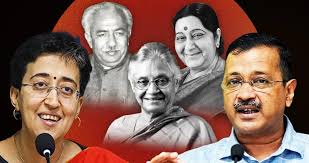Comprehensive Overview of Delhi’s Chief Ministers and Their Tenures
Introduction
Delhi, the capital city of India, has witnessed a dynamic political landscape since its first legislative assembly elections in 1952. Over the decades, various leaders from different political parties have assumed the role of Chief Minister (CM), each contributing uniquely to the city’s development and governance. This article provides an in-depth look into the history of Delhi’s Chief Ministers, their tenures, and their significant contributions.
Early Years and the Inception of the Chief Minister’s Office
The inaugural legislative assembly elections in Delhi were held in 1952, marking a significant milestone in the city’s political history. Chaudhary Brahm Prakash of the Indian National Congress (INC) emerged as the first Chief Minister, serving from March 17, 1952, to February 12, 1955. His tenure focused on laying the foundational framework for Delhi’s administrative and developmental policies. Following him, Gurmukh Nihal Singh took office on February 12, 1955, and served until November 1, 1956. During this period, Delhi underwent significant administrative changes, leading to the temporary abolition of the Chief Minister’s office as the city came under central government rule.
Reinstatement of the Chief Minister’s Office and Political Resurgence
After a prolonged period without a local governing head, the Chief Minister’s office was reinstated in 1993. Madan Lal Khurana of the Bharatiya Janata Party (BJP) became the CM on December 2, 1993, serving until February 26, 1996. His leadership marked the beginning of a new political era in Delhi, focusing on infrastructure development and urban planning. Succeeding him, Sahib Singh Verma held the position from February 26, 1996, to October 12, 1998, emphasizing rural development and education. In a brief tenure, Sushma Swaraj served as the CM from October 12, 1998, to December 3, 1998, becoming the first woman to hold the office in Delhi.
The Era of Sheila Dikshit: Longest-Serving Chief Minister
Sheila Dikshit of the INC assumed office on December 3, 1998, and remained in power until December 28, 2013, making her the longest-serving Chief Minister of Delhi. Her 15-year tenure is often credited with transforming Delhi’s infrastructure, including the expansion of the Delhi Metro, flyovers, and initiatives aimed at making Delhi a more livable city. Her leadership also focused on improving public services and urban development, leaving a lasting impact on the city’s landscape.
The Rise of the Aam Aadmi Party and Recent Developments
The political scenario witnessed a significant shift with the emergence of the Aam Aadmi Party (AAP). Arvind Kejriwal, leading the AAP, first took office on December 28, 2013, but resigned on February 14, 2014. After a period of President’s Rule, he returned to power on February 14, 2015, and served consecutive terms until September 17, 2024. His governance focused on education, healthcare, and anti-corruption measures. Following his tenure, Atishi Marlena Singh briefly held the position from September 17, 2024, to February 20, 2025. As of February 20, 2025, Rekha Gupta of the BJP has taken oath as the Chief Minister, marking the party’s return to power in Delhi after 27 years. Her leadership is anticipated to bring fresh perspectives to Delhi’s governance, focusing on community development and women’s empowerment.

Why This News Is Important
Significance for Competitive Exam Aspirants
Understanding the chronological progression of Delhi’s Chief Ministers is crucial for students preparing for government exams. Questions related to political history, significant political figures, and their contributions are common in examinations for positions such as civil services, banking, and defense. Knowledge of this topic not only aids in answering direct questions but also provides context for understanding Delhi’s administrative evolution.
Implications for Delhi’s Administrative and Political Landscape
The recent appointment of Rekha Gupta as Delhi’s Chief Minister signifies a notable political shift, with the BJP returning to power after nearly three decades. This change is expected to influence policy directions, administrative priorities, and governance models in the National Capital Territory. Staying informed about such developments is essential for aspirants aiming for roles in public administration and governance, as it reflects the dynamic nature of political scenarios and their impact on administrative strategies.
Historical Context
Evolution of Delhi’s Political Structure
Delhi’s political structure has undergone significant transformations since India’s independence. Initially, Delhi was a Part-C state with its own legislative assembly and Chief Minister. However, in 1956, the States Reorganisation Act led to the dissolution of the assembly, bringing Delhi under direct central administration. This arrangement continued until 1991, when the 69th Constitutional Amendment granted Delhi the status of the National Capital Territory with a legislative assembly, reinstating the position of the Chief Minister. These changes reflect the evolving governance needs of a growing metropolis and its significance as the nation’s capital.
Key Takeaways from the Evolution of Delhi’s Chief Ministers
| S.No. | Key Takeaway |
|---|---|
| 1 | First Chief Minister: Chaudhary Brahm Prakash served from 1952 to 1955. |
| 2 | Longest-Serving Chief Minister: Sheila Dikshit held office for 15 years (1998-2013). |
| 3 | First Female Chief Minister: Sushma Swaraj served briefly in 1998. |
| 4 | Reinstatement of the CM’s Office: The position was abolished in 1956 and reinstated in 1993. |
| 5 | Recent Political Shift: Rekha Gupta of BJP became CM in February 2025 after 27 years. |
Important FAQs for Students from this News
Q1: Who was the first Chief Minister of Delhi?
A1: Chaudhary Brahm Prakash was the first CM of Delhi, serving from 1952 to 1955.
Q2: Who is the longest-serving Chief Minister of Delhi?
A2: Sheila Dikshit served as CM for 15 years from 1998 to 2013, making her the longest-serving CM.
Q3: When was the Chief Minister’s office in Delhi reinstated?
A3: The office was reinstated in 1993 after being abolished in 1956.
Q4: Which political party has ruled Delhi for the longest time?
A4: The Indian National Congress (INC) ruled for the longest period, with Sheila Dikshit serving three consecutive terms.
Q5: Who is the current Chief Minister of Delhi as of 2025?
A5: Rekha Gupta of the Bharatiya Janata Party (BJP) became CM in February 2025.
Some Important Current Affairs Links


















 Exciting News!
Exciting News!  Join Our Telegram Channel Now!
Join Our Telegram Channel Now!
 Join our Telegram channel for a thrilling adventure into the world of daily current affairs.
Join our Telegram channel for a thrilling adventure into the world of daily current affairs. 
 Don’t miss out on the latest updates and insights! Click to join now and be part of the knowledge revolution!
Don’t miss out on the latest updates and insights! Click to join now and be part of the knowledge revolution! 
